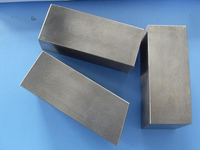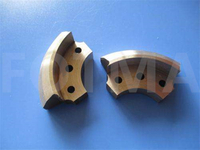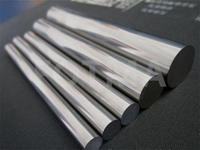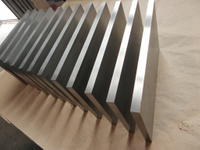Views: 19 Author: Site Editor Publish Time: 2020-11-10 Origin: Site
Cemented carbide is the most widely used type of high-speed machining (HSM) tool material. This type of material is produced by powder metallurgy, and consists of hard carbide (usually tungsten carbide WC) particles and a softer metal bond composition. At present, there are hundreds of WC-based cemented carbides with different compositions. Most of them use cobalt (Co) as a binder. Nickel (Ni) and chromium (Cr) are also commonly used binder elements, and other elements can be added. Some alloying elements.
Combination changes of different types of tungsten carbide powder, mixture composition and metal bond content, and the type and amount of grain growth inhibitors, constitute a variety of cemented carbide grades. These parameters will determine the microstructure and characteristics of the cemented carbide. Certain specific performance combinations have become the first choice for specific processing applications, which makes it meaningful to classify a variety of cemented carbide grades.
The two most commonly used cemented carbide classification systems for processing purposes are the C grade system and the ISO grade system. Although neither of these two systems can fully reflect the material properties that affect the choice of cemented carbide grades, they provide a starting point for discussion. For each classification, many manufacturers have their own special grades, resulting in a wide variety of carbide grades.
Cemented carbide grades can also be classified according to composition. Tungsten carbide (WC) grades can be divided into three basic types: simple type, microcrystalline type and alloy type. Simple grades are mainly composed of tungsten carbide and cobalt binders, but they may also contain a small amount of grain growth inhibitors. Microcrystalline grades are composed of tungsten carbide and cobalt binder added with a few thousandths of vanadium carbide (VC) and/or chromium carbide (Cr3C2), and its grain size can reach 1μm or less. Alloy grades are composed of tungsten carbide and a cobalt binder containing several percent of titanium carbide (TiC), tantalum carbide (TaC) and niobium carbide (NbC). These additives are also called cubic carbides because of their sintering The latter microstructure showed an uneven three-phase structure.
(1) Simple type cemented carbide grades
Such grades used for metal cutting usually contain 3%-12% cobalt (weight ratio). The size range of tungsten carbide grains is usually between 1-8 μm. Like other grades, reducing the particle size of tungsten carbide can increase its hardness and transverse fracture strength (TRS), but it will reduce its toughness. The hardness of simple grades is usually between HRA89-93.5; the transverse fracture strength is usually between 175-350ksi. The powder of this type may contain a large amount of recycled raw materials.
Simple grades can be classified into C1-C4 in the C grade system, and can be classified according to the K, N, S and H grade series in the ISO grade system. Simple grades with intermediate characteristics can be classified as general grades (such as C2 or K20), which can be used for turning, milling, planing and boring; grades with smaller grain size or lower cobalt content and higher hardness can be used It is classified as finishing grade (such as C4 or K01); grades with larger grain size or cobalt content and better toughness can be classified as rough finishing grades (such as C1 or K30).
Tools made with simplex grades can be used for cutting cast iron, 200 and 300 series stainless steel, aluminum and other non-ferrous metals, high-temperature alloys and hardened steel. Such grades can also be used in non-metal cutting fields (such as as rock and geological drilling tools). The grain size of these grades is in the range of 1.5-10μm (or larger), and the cobalt content is 6%-16%. Another non-metal cutting application of simple cemented carbide grades is to make dies and punches. These grades usually have a medium grain size and a cobalt content of 16%-30%.
(2) Microcrystalline cemented carbide grades
Such grades usually contain 6%-15% cobalt. During liquid phase sintering, the added vanadium carbide and (or) chromium carbide can control the growth of grains, thereby obtaining a fine grain structure with a grain size of less than 1 μm. This fine-grained grade has a very high hardness and a transverse fracture strength above 500ksi. The combination of high strength and sufficient toughness allows such brands of tools to adopt a larger positive rake angle, which can reduce cutting force and produce thinner chips by cutting rather than pushing metal materials.
Through strict quality identification of various raw materials in the production of grades of cemented carbide powder, and strict control of sintering process conditions to prevent the formation of abnormal large grains in the microstructure of the material, appropriate The material properties. In order to keep the grain size small and uniform, the recycled recycled powder can only be used when the raw materials and recycling process can be fully controlled, and extensive quality inspections are implemented.
Microcrystalline grades can be classified according to the M grade series in the ISO grade system. Apart from this, the other classification methods in the C grade system and the ISO grade system are the same as the simple grades. Microcrystalline grades can be used to make tools for cutting softer workpiece materials, because the surface of this tool can be machined very smoothly and can maintain extremely sharp cutting edges.
Microcrystalline tools can also be used to process nickel-based super alloys, because this tool can withstand cutting temperatures as high as 1200°C. For the processing of high-temperature alloys and other special materials, the use of microcrystalline brand tools and simple brand tools containing ruthenium can simultaneously improve its wear resistance, deformation resistance and toughness. Microcrystalline grades are also suitable for manufacturing rotating tools (such as drills) that generate shear stress. There is a drill bit made of composite grades of cemented carbide. The cobalt content in the material varies in a specific part of the same drill bit, thereby optimizing the hardness and toughness of the drill bit according to processing needs.
(3) Alloy type cemented carbide grades
This type of grade is mainly used for cutting steel parts, the cobalt content is usually 5%-10%, and the grain size range is 0.8-2μm. By adding 4%-25% titanium carbide (TiC), the tendency of tungsten carbide (WC) to diffuse to the surface of steel chips can be reduced. By adding no more than 25% of tantalum carbide (TaC) and niobium carbide (NbC), the strength, crater wear resistance and thermal shock resistance of the tool can be improved. Adding such cubic carbides can also improve the red hardness of the tool, and help avoid thermal deformation of the tool in heavy cutting or other machining where the cutting edge will generate high temperatures. In addition, titanium carbide can provide nucleation sites during the sintering process and improve the uniformity of cubic carbide distribution in the workpiece.
Generally speaking, the hardness range of alloy type cemented carbide grades is HRA91-94, and the transverse fracture strength is 150-300ksi. Compared with simple grades, alloy grades have poorer wear resistance and lower strength, but they have better resistance to adhesive wear. Alloy type grades can be classified into C5-C8 in the C grade system, and can be classified according to the P and M grade series in the ISO grade system. Alloy grades with intermediate characteristics can be classified as general grades (such as C6 or P30), which can be used for turning, tapping, planing and milling. The grades with the highest hardness can be classified as finishing grades (such as C8 and P01) for fine turning and boring processing. These grades usually have smaller grain sizes and lower cobalt content to obtain the required hardness and wear resistance. However, similar material properties can be obtained by adding more cubic carbides. The toughest grades can be classified as roughing grades (such as C5 or P50). These grades usually have a medium size particle size and high cobalt content, and the addition of cubic carbides is also small, in order to obtain the required toughness by inhibiting crack propagation. In the intermittent turning process, the cutting performance can be further improved by using the cobalt-rich grades with higher cobalt content on the tool surface.
Alloy grades with lower titanium carbide content are used for cutting stainless steel and malleable cast iron, but can also be used for processing non-ferrous metals (such as nickel-based super alloys). The grain size of these grades is usually less than 1μm, and the cobalt content is 8%-12%. Grades with higher hardness (such as M10) can be used for turning and processing malleable cast iron; grades with better toughness (such as M40) can be used for milling and planing steel, or for turning stainless steel or super alloys.
Alloy-type cemented carbide grades can also be used for non-metal cutting purposes, mainly for the manufacture of wear-resistant parts. These grades usually have a particle size of 1.2-2μm and a cobalt content of 7%-10%. In the production of these grades, a large proportion of recycled raw materials are usually added to obtain higher cost-effectiveness in the application of wear-resistant parts. Wear-resistant parts need to have good corrosion resistance and high hardness. When producing such grades, these properties can be obtained by adding nickel and chromium carbide.





